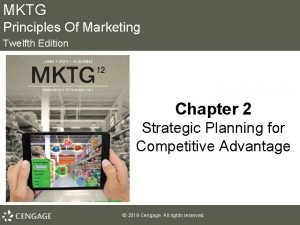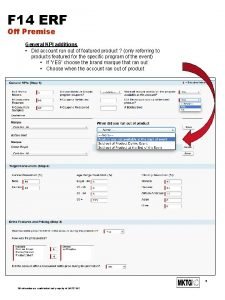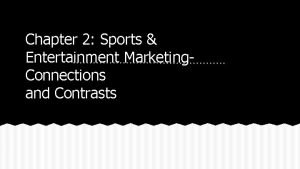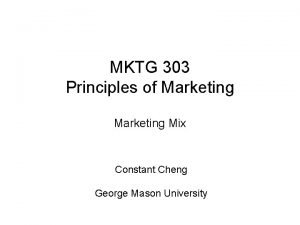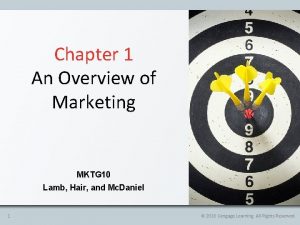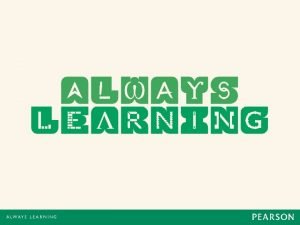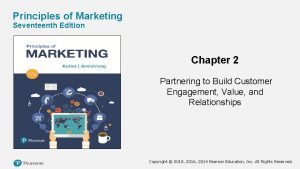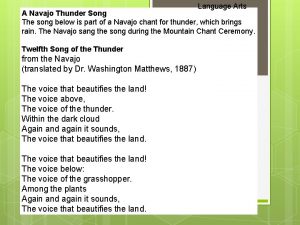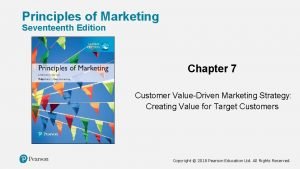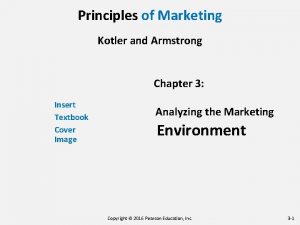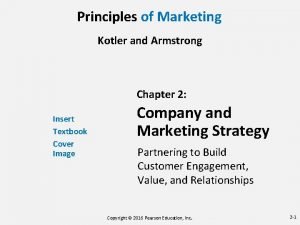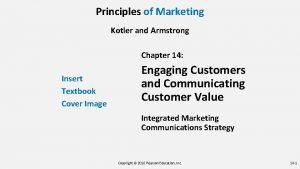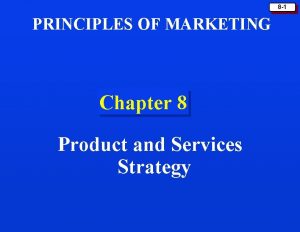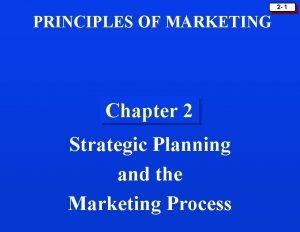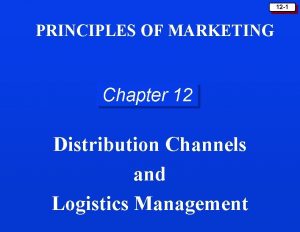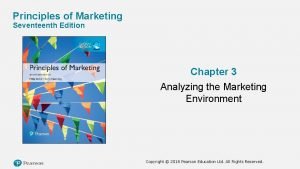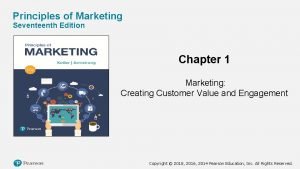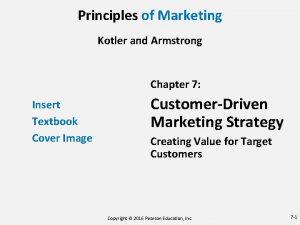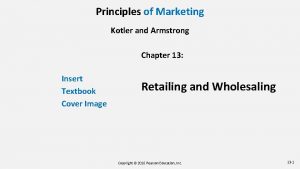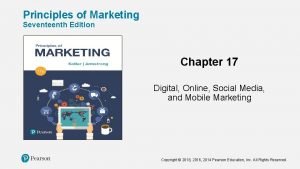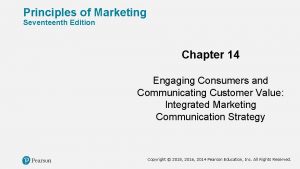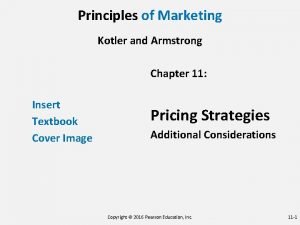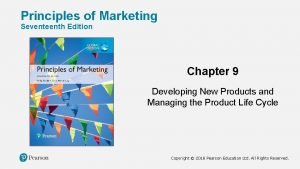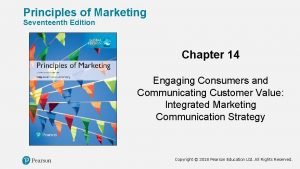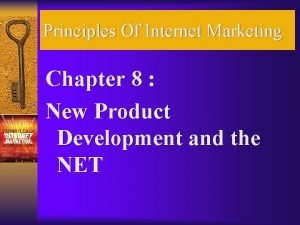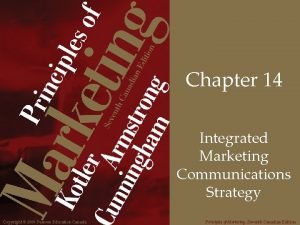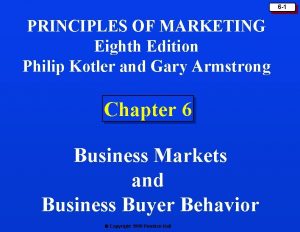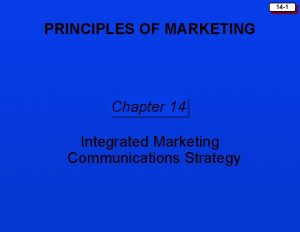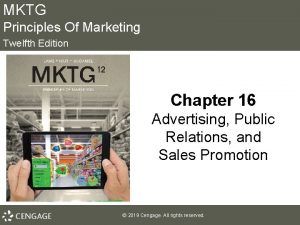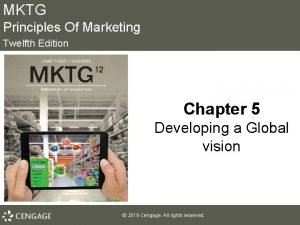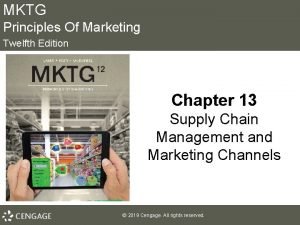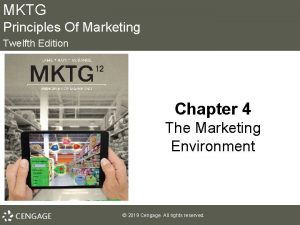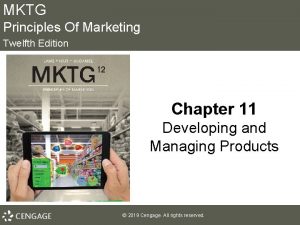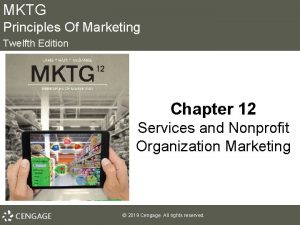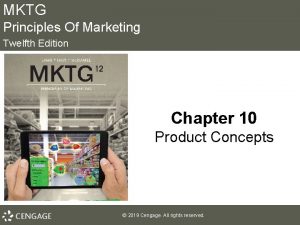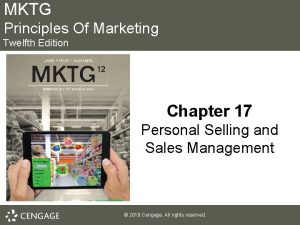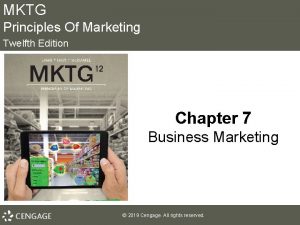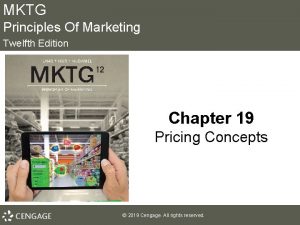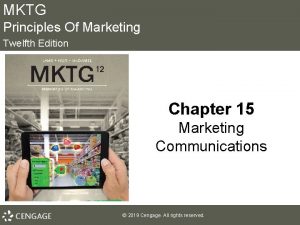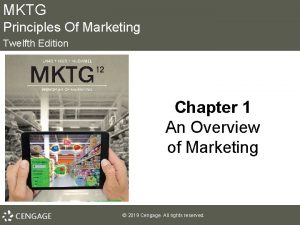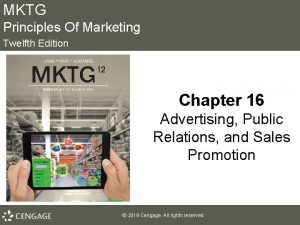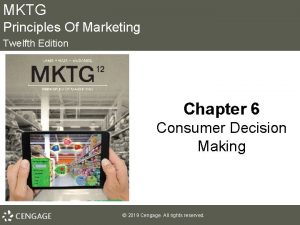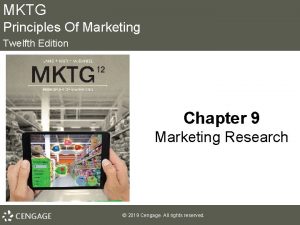MKTG Principles Of Marketing Twelfth Edition Chapter 2























































- Slides: 55

MKTG Principles Of Marketing Twelfth Edition Chapter 2 Strategic Planning For Competitive Advantage © 2019 Cengage. All rights reserved.

Learning Outcomes (1 of 2) 2 -1 Understand the importance of strategic planning 2 -2 Define strategic business units (SBUs) 2 -3 Identify strategic alternatives and know a basic outline for a marketing plan 2 -4 Develop an appropriate business mission statement 2 -5 Describe the components of a situation analysis 2 -6 Identify sources of competitive advantage 2 -7 Explain the criteria for stating good marketing objectives 2 -8 Discuss target market strategies 2 -9 Describe the elements of the marketing mix © 2019 Cengage. All rights reserved.

Learning Outcomes (2 of 2) 2 -10 Explain why implementation, evaluation, and control of the marketing plan are necessary 2 -11 Identify several techniques that help make strategic planning effective © 2019 Cengage. All rights reserved.

Learning Objective 1: The Nature of Strategic Planning © 2019 Cengage. All rights reserved.

Strategic Planning • Creating and maintaining a fit between the organization’s objectives and resources and the evolving market opportunities • Addresses two questions: – What is the organization’s main activity at a particular time? – How will it reach its goals? © 2019 Cengage. All rights reserved.

Learning Objective 2: Strategic Business Units © 2019 Cengage. All rights reserved.

Characteristics of Strategic Business Units (SBUs) • • Distinct mission and specific target market Control over its resources Its own competitors A single business or a collection of related businesses • Plans independent of other SBUs in the total organization © 2019 Cengage. All rights reserved.

Learning Objective 3: Strategic Alternatives © 2019 Cengage. All rights reserved.

Ansoff’s Strategic Opportunity Matrix • A method for developing alternatives is Ansoff’s strategic opportunity matrix, which matches products with markets – Market penetration: Increase market share among existing customers – Market development: Attract new customers to existing products – Product development: A strategy entailing the creation of new products for present markets – Diversification: A strategy of increasing sales by introducing new products into new markets © 2019 Cengage. All rights reserved.

Exhibit 2. 1 Ansoff’s Opportunity Matrix © 2019 Cengage. All rights reserved.

The Innovation Matrix (1 of 2) • Critics of Ansoff’s matrix mention that the matrix does not reflect the reality of how businesses grow—that modern businesses plan growth in a more fluid manner based on current capabilities rather than the clear-cut sectors outlined by the opportunity matrix. • Core Innovation: These decisions implement changes that use existing assets to provide added convenience to existing customers and potentially entice customers from other brands. Packaging changes, such as Tide’s laundry detergent pods, fall into this category. © 2019 Cengage. All rights reserved.

The Innovation Matrix (2 of 2) • Adjacent Innovation: These decisions are designed to take company strengths into new markets. This space uses existing abilities in new ways. For example, Botox, the popular cosmetic drug, was originally developed to treat intestinal problems and to treat crossed eyes. Leveraging the drug into cosmetic medicine has dramatically increased the market for Botox. • Transformational Innovation: These decisions result in brand-new markets, products, and often new businesses. The company must rely on new, unfamiliar assets to develop the type of breakthrough decisions that fall in this category. © 2019 Cengage. All rights reserved.

Exhibit 2. 2 Innovation Matrix © 2019 Cengage. All rights reserved.

The Boston Consulting Group Model (1 of 2) • The portfolio matrix classifies each SBU by its present or forecast growth and market share. • The measure of market share used in the portfolio approach is relative market share, the ratio between the company’s share and the share of the largest competitor. • The portfolio matrix breaks SBUs into four categories: – Stars: A star is a fast-growing market leader. – Cash cows: A cash cow is an SBU that generates more cash than it needs to maintain its market share. © 2019 Cengage. All rights reserved.

The Boston Consulting Group Model (2 of 2) – Problem children: A problem child, also called a question mark, shows rapid growth but poor profit margins. – Dogs: A dog has low growth potential and a small market share. © 2019 Cengage. All rights reserved.

Exhibit 2. 3 Portfolio Matrix for a Large Computer Manufacturer © 2019 Cengage. All rights reserved.

Strategies Used to Allocate Future Resources • After classifying the SBUs, a company must determine how to allocate resources to each SBU. • Build: If an SBU has the potential to be a star, building would be an appropriate goal. • Hold: If an SBU is a successful cash cow, a key goal would be to hold or preserve market share. • Harvest: This is an appropriate strategy for all SBUs except stars. The basic goal is to increase short-term cash return without much concern for the long-run impact. • Divest: Getting rid of SBUs with low shares of low-growth markets is often appropriate. Problem children and dogs are suitable for this strategy. © 2019 Cengage. All rights reserved.

Exhibit 2. 4 General Electric Model © 2019 Cengage. All rights reserved.

Marketing Plan • Planning – Process of anticipating future events and determining strategies to achieve organizational objectives in the future • Marketing planning – Designing activities relating to marketing objectives and the changing marketing environment • Marketing plan – Written document that acts as a guidebook of marketing activities for the marketing manager © 2019 Cengage. All rights reserved.

Objectives of a Marketing Plan • To provide clearly stated activities that help employees and managers understand work toward common goals • To allow the examination of the marketing environment in conjunction with the inner workings of the businesses • To help marketing managers enter the marketplace with an awareness of problems and opportunities © 2019 Cengage. All rights reserved.

Exhibit 2. 5 Elements of a Marketing Plan © 2019 Cengage. All rights reserved.

Learning Objective 4: Defining the Business Mission © 2019 Cengage. All rights reserved.

Mission Statement • Statement of a firm's business based on the analysis of: – Benefits sought by present and potential customers – Existing and anticipated environmental conditions • Suffers from marketing myopia if stated narrowly – Marketing myopia: Defining a business in terms of goods and services rather than the benefits customers seek © 2019 Cengage. All rights reserved.

Learning Objective 5: Conducting a Situational Analysis © 2019 Cengage. All rights reserved.

SWOT Analysis • Situational analysis by which firms should: – Identify their internal strengths and weaknesses § Done by focusing on organizational resources – Examine their external opportunities and threats § Done via environmental scanning, which involves analyzing aspects of the marketing environment © 2019 Cengage. All rights reserved.

Learning Objective 6: Competitive Advantage © 2019 Cengage. All rights reserved.

Competitive Advantage • Factor or factors that cause customers to patronize a firm and not the competition • Types: – Cost – Product/service differentiation – Niche © 2019 Cengage. All rights reserved.

Cost Competitive Advantage (1 of 2) • Being the low-cost competitor in an industry while maintaining satisfactory profit margins • Sources of cost reduction: – Experience curves, efficient labor, no-frills products, government subsidies, product design, reengineering, production, innovations, and new methods of service delivery § Efficient labor: Labor costs can be an important component of total costs in low-skill, labor-intensive industries. § No-frills products: Removing frills and options from a product or service can reduce costs. § Government subsidies : Governments may provide grants and interest-free loans to target industries © 2019 Cengage. All rights reserved.

Cost Competitive Advantage (2 of 2) – Product design: Cutting-edge design and reverse engineering can offset costs. – Reengineering: Fundamental rethinking and redesign of business processes help achieve dramatic improvements in critical measures of performance. – Product innovations: New technology and simplified production techniques can reduce the average production costs. – New methods of service delivery: Medical expenses have been lowered by the use of outpatient surgery and walkin clinics. Online-only magazines can help save on material and shipping costs © 2019 Cengage. All rights reserved.

Product/Service Differentiation Competitive Advantage • Provision of something unique and valuable to buyers beyond simply offering a lower price than competitors – – – Brand names Strong dealer network Product reliability Image Service © 2019 Cengage. All rights reserved.

Niche Competitive Advantage • Seeks to target and effectively serve a single segment of the market • Used by small companies with limited resources • May be used in a limited geographic market • Effective for market segments with good growth potential but is not crucial to success of competitors © 2019 Cengage. All rights reserved.

Building Sustainable Competitive Advantage • Advantage that cannot be copied by the competition • Notion is that a successful firm will stake out a position unique in some manner from its rivals • Sources: Skills and assets of an organization – Patents, copyrights, locations, equipment, technology, customer service, and promotion © 2019 Cengage. All rights reserved.

Learning Objective 7: Setting Marketing Plan Objectives © 2019 Cengage. All rights reserved.

Marketing Objective • Statement of what is to be accomplished through marketing activities • Should be: – Realistic: Managers should develop objectives that have a chance of being met. – Measurable: Managers need to be able to quantitatively measure whether or not an objective has been met. – Time specific: By what time should the objective be met? – Compared to a benchmark: The objective is to increase sales by 15 percent; it is important to know the baseline against which the objective will be measured. © 2019 Cengage. All rights reserved.

Effective Marketing Objectives • Communicate marketing management philosophy • Provide directions for lower-level marketing managers to integrate and point marketing efforts in a consistent direction • Motivate employees • Force executives to clarify their thinking • Form a basis for control © 2019 Cengage. All rights reserved.

Learning Objective 8: Describing the Target Market © 2019 Cengage. All rights reserved.

Target Market Strategy (1 of 2) • Marketing strategy: Produces mutually satisfying exchanges with target markets – By selecting and describing one or more target markets and developing and maintaining a marketing mix • Segments based on groups with similar characteristics through market opportunity analysis • Selects one or more target markets © 2019 Cengage. All rights reserved.

Target Market Strategy (2 of 2) • Appeal to the entire market with one marketing mix • Concentrate on one marketing segment • Appeal to multiple market segments with multiple marketing mixes © 2019 Cengage. All rights reserved.

Learning Objective 9: The Marketing Mix © 2019 Cengage. All rights reserved.

The Marketing Mix • Unique blend of product, place (distribution), promotion, and pricing strategies – Designed to produce mutually satisfying exchanges with a target market • Elements are often referred to as the four Ps © 2019 Cengage. All rights reserved.

Marketing Mix: The “Four Ps” (1 of 4) • Product: – The product is the starting point of the marketing mix. It is difficult to decide on a promotion campaign, determine a price, or design a distribution strategy until the product offering and product strategy are defined. – The product is not only the physical unit but also its package, warranty, after-sale service, brand name, company image, value, and other factors. – Product involves tangible goods, ideas, or services © 2019 Cengage. All rights reserved.

Marketing Mix: The “Four Ps” (2 of 4) • Place involves: – Physical distribution that includes storage and transportation – Making product available where and when customers want them – Ensuring that products arrive in usable condition at designated places when needed © 2019 Cengage. All rights reserved.

Marketing Mix: The “Four Ps” (3 of 4) • Promotion: – Includes advertising, public relations, sales promotion, and personal selling – Brings about mutually satisfying exchanges by informing, educating, persuading, and reminding buyers about the product – Each element of the promotion mix is coordinated with the others to create a promotional blend. – A good promotion strategy can increase sales. • Price: – What a buyer must give up to obtain a product – Most flexible of the “four Ps” © 2019 Cengage. All rights reserved.

Marketing Mix: The “Four Ps” (4 of 4) – Price is an important competitive weapon. Of the four Ps, it can be changed most quickly. – Price multiplied by the number of units sold equals total revenue for the firm. © 2019 Cengage. All rights reserved.

Learning Objective 10: Following up on the Marketing Plan © 2019 Cengage. All rights reserved.

Steps Involved in Following up on the Marketing Plan (1 of 3) • Implementation: – Turns a marketing plan into action assignments – Ensures these assignments are executed in a way that accomplishes the plan's objectives • Evaluation and Control: – Gauges the extent to which the marketing objectives have been achieved during the specified time period – Provides the mechanisms for: § Evaluating marketing results in light of the plan's objectives § Correcting actions that do not help the organization reach those objectives within budget guidelines © 2019 Cengage. All rights reserved.

Steps Involved in Following up on the Marketing Plan (2 of 3) – Exerted through marketing audit: § Helps management allocate marketing resources efficiently © 2019 Cengage. All rights reserved.

Steps Involved in Following up on the Marketing Plan (3 of 3) Post-Audit Tasks: • To profile and make recommendations about weaknesses and inhibiting factors as well as strengths and new opportunities • To ensure that the role of the audit has been clearly communicated • To make someone accountable for implementing recommendations © 2019 Cengage. All rights reserved.

Learning Objective 11: Effective Strategic Planning © 2019 Cengage. All rights reserved.

Effective Strategic Planning • Effective strategic planning requires continual attention, creativity, and management commitment. • Strategic planning should not be an annual exercise in which managers go through the motions and forget about strategic planning until the next year. • It should be an ongoing process because the environment is continually changing and the firm’s resources and capabilities are continually evolving. • Sound strategic planning is based on creativity. Managers should challenge assumptions about the firm and the environment and establish new strategies. • Perhaps the most critical element in successful strategic planning is top management’s support and participation. © 2019 Cengage. All rights reserved.

Techniques for Effective Strategic Planning • Continual attention • Creativity • Management commitment © 2019 Cengage. All rights reserved.

Key Terms (1 of 4) • • • Strategic planning Strategic business unit (SBU) Market penetration Market development Product development Diversification Portfolio matrix Star Cash cow Problem child (question mark) © 2019 Cengage. All rights reserved.

Key Terms (2 of 4) • • • Dog Planning Marketing plan Mission statement Marketing myopia SWOT analysis Environmental scanning Competitive advantage Cost competitive advantage © 2019 Cengage. All rights reserved.

Key Terms (3 of 4) • • Experience curves Product/service differentiation competitive advantage Niche competitive advantage Sustainable competitive advantage Marketing objective Marketing strategy Market opportunity analysis (MOA) Marketing mix (four Ps) © 2019 Cengage. All rights reserved.

Key Terms (4 of 4) • • Implementation Evaluation Control Marketing audit © 2019 Cengage. All rights reserved.
 Mktg 12th edition
Mktg 12th edition Mktg 12 principles of marketing
Mktg 12 principles of marketing Principles of marketing chapter 9
Principles of marketing chapter 9 Ricky w griffin management 12th edition
Ricky w griffin management 12th edition Mktg 8
Mktg 8 Diageo emc
Diageo emc Chapter 2 sports and entertainment marketing
Chapter 2 sports and entertainment marketing Mktg 303
Mktg 303 Mktg 10
Mktg 10 Principles of marketing fifth european edition
Principles of marketing fifth european edition Marketing management (arab world edition)
Marketing management (arab world edition) Chapter 2 principles of marketing
Chapter 2 principles of marketing Principles of marketing module 2 grade 11
Principles of marketing module 2 grade 11 Using mis 10th edition
Using mis 10th edition Zulily case study
Zulily case study Night structure
Night structure Twelfth night ppt
Twelfth night ppt Cesario come for so you shall be
Cesario come for so you shall be Structure of twelfth night
Structure of twelfth night What is the main conflict in twelfth night
What is the main conflict in twelfth night Twelfth night act 1 summary
Twelfth night act 1 summary Duke orsino
Duke orsino Themes in twelfth night
Themes in twelfth night Language
Language Twelfth night act 5
Twelfth night act 5 Duke orsino character analysis
Duke orsino character analysis Jenny phelps
Jenny phelps Msik
Msik Satire in twelfth night
Satire in twelfth night Deverell twelfth night
Deverell twelfth night Disappeared silent night
Disappeared silent night Shakespearean comedy vs tragedy
Shakespearean comedy vs tragedy Chapter 7 marketing
Chapter 7 marketing Marketing chapter 5
Marketing chapter 5 Chapter 3 marketing
Chapter 3 marketing Marketing mix kotler and armstrong
Marketing mix kotler and armstrong Marketing chapter 14
Marketing chapter 14 Product line decisions
Product line decisions Principle of marketing chapter 2
Principle of marketing chapter 2 Principles of marketing chapter 12
Principles of marketing chapter 12 Principles of marketing chapter 3
Principles of marketing chapter 3 Marketing creating customer value and engagement
Marketing creating customer value and engagement Principles of marketing chapter 7
Principles of marketing chapter 7 Principles of marketing chapter 13
Principles of marketing chapter 13 Principles of marketing chapter 17
Principles of marketing chapter 17 Principles of marketing chapter 14
Principles of marketing chapter 14 Marketing chapter 11
Marketing chapter 11 Principles of marketing chapter 9
Principles of marketing chapter 9 Principles of marketing chapter 14
Principles of marketing chapter 14 Principles of internet marketing
Principles of internet marketing Principles of marketing chapter 14
Principles of marketing chapter 14 Principles of marketing chapter 6
Principles of marketing chapter 6 Principles of marketing chapter 5
Principles of marketing chapter 5 Principles of marketing chapter 14
Principles of marketing chapter 14 Failure of supporting utilities and structural collapse
Failure of supporting utilities and structural collapse Principles of electronic communication systems 3rd edition
Principles of electronic communication systems 3rd edition
